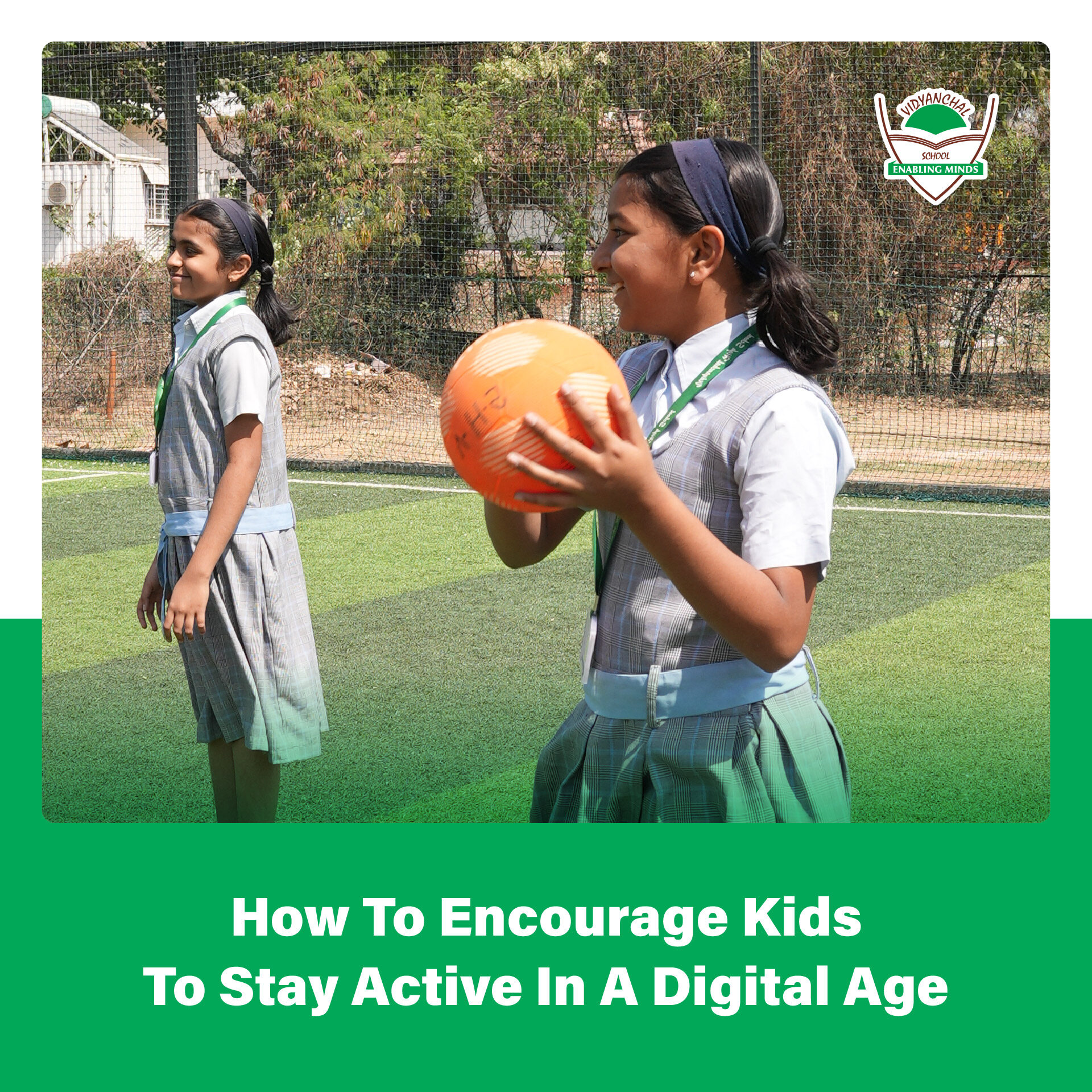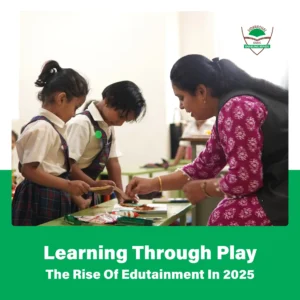In today’s world, children are growing up with screens as companions—from online classes and mobile games to streaming videos and virtual playdates. While digital exposure has its benefits, it has also made physical activity seem optional, or worse, inconvenient. The result? Rising cases of screen dependency, reduced stamina, poor posture, and in some cases, even early-onset lifestyle issues in children.
At Vidyanchal School, we recognise that this isn’t a simple problem of “too much screen time.” It’s a cultural shift, and like all shifts, it requires thoughtful balance. Encouraging kids to stay active in a digital age isn’t about banning screens—it’s about offering compelling, meaningful alternatives that spark curiosity and joy.
Let’s explore how parents can create a healthier rhythm of movement, play, and screen use for their children.
The Modern Childhood: Indoors, Plugged In, Less Active
Compared to previous generations, today’s children spend far less time outdoors. The reasons are understandable: smaller play spaces, traffic-heavy cities, long academic schedules, and the omnipresence of digital entertainment. Add to that the comfort and convenience of staying indoors, and the scales tip easily toward a sedentary lifestyle.
Unfortunately, this shift can affect not only physical health but also social skills, mood regulation, and even academic performance. Movement is not just good for the body—it helps with focus, reduces anxiety, and boosts memory. Several studies show that children who are physically active have better classroom behaviour and sharper cognitive abilities.
Understanding What “Active” Really Means
Before we talk about how to encourage activity, it helps to define it. Being active doesn’t necessarily mean being athletic. Your child doesn’t have to join a sports academy to be considered active. Activity can be:
- Riding a bicycle around the building
- Dancing to music at home
- Playing catch or hide-and-seek with friends
- Gardening, running errands, or walking the dog
- Skipping, stretching, or climbing stairs
The goal is movement—the more natural and joyful, the better. Structured sport has its place, but everyday activity is just as important.
At Vidyanchal, we try to integrate movement into regular school routines—not just during PE periods. From movement-based learning in early years to yoga and nature walks in later classes, we believe movement enhances not just fitness but also emotional balance.
This is something we explored in our blog on why holistic education matters, where physical, emotional, and intellectual growth are all considered part of the same developmental journey.
Why Are Kids Less Interested in Physical Activity Today?
The most obvious answer is screens. But it’s not just that gadgets are distracting—it’s that they are designed to be addictive. Games and videos offer instant feedback, vibrant visuals, and rewards. In contrast, traditional play may feel slower or less exciting.
Moreover, modern play is often constrained by schedules and safety concerns. Children have fewer unsupervised hours and less access to open, safe play areas. They are often expected to perform even during “free play”—through trophies, rankings, or assessments.
That’s why one of the most effective ways to encourage children to move more is to bring joy back into movement—make it social, spontaneous, and screen-free.
How to Encourage Movement in Daily Life
1. Be an Example, Not an Instructor
Children imitate more than they obey. If you spend time on your phone while urging your child to go out and play, they will follow your actions, not your words. Instead, try integrating movement into your own day—go for evening walks, do stretches in the living room, or try simple yoga routines. When your child sees you enjoying movement, they’ll be curious to join.
Making it a family activity is even better. A short walk after dinner or a weekly trek can create bonding time while improving physical health.
2. Create Screen-Free Time Blocks
Instead of banning screens completely, set specific hours where gadgets are off-limits. After school and before dinner is an ideal time block to encourage outdoor play or indoor movement. Use this time to offer alternatives like crafts, board games, dance challenges, or even helping out in the kitchen.
Children are more likely to try something new when they’re not competing with the constant stimulation of a screen. Consistent routines around device use also help reduce resistance over time.
This idea of creating structured freedom echoes some of the themes in our post on nurturing 21st-century skills in school environments, where we talk about promoting independence within thoughtful boundaries.
3. Make Outdoor Play a Daily Priority
Even 30 minutes of unstructured outdoor time can make a difference. If your neighbourhood doesn’t have a playground, even a walk in the compound, games like hopscotch or skipping, or balcony play with balls and hoops can help.
Some parents plan weekend park visits or playdates to break the monotony of indoor life. Encouraging your child to meet friends offline makes them more invested in outdoor play.
If space is limited, consider creative indoor movement—obstacle courses, yoga videos for kids, or follow-the-leader games can be surprisingly effective.
4. Choose Movement-Based Activities That Match Your Child’s Interests
Not every child enjoys cricket or football. Some may prefer dance, martial arts, skating, or swimming. Others may enjoy hiking, cycling, or indoor climbing. Let your child explore different forms of movement until they find something that feels natural and fun. The goal isn’t to master a sport—it’s to love being active.
Encouraging autonomy in this way helps children build confidence and commitment. A child who chooses their activity is far more likely to stick with it than one who’s forced into a schedule.
5. Reward Consistency, Not Performance
Avoid framing physical activity as something children must do to be “fit” or “slim.” Instead, celebrate their effort. “You’ve played every evening this week!” is more motivating than “You ran the fastest today.”
When children learn to associate movement with joy rather than judgment, they’re more likely to stay active as they grow. This also reduces the pressure to constantly perform or compare themselves with others.
Managing Screen Time With Compassion
While reducing screen time is important, it’s equally vital to approach it with understanding. For many children, screens are also sources of connection, creativity, or downtime. The idea is not to demonise technology, but to rebalance the scale so that digital time doesn’t displace real-world exploration and interaction.
One helpful strategy is to co-watch or co-play once in a while. When you understand the digital content your child is drawn to, you can suggest real-world activities that extend those interests. For instance, a child who loves cooking games might enjoy helping out in the kitchen. A child fascinated by nature documentaries might enjoy a trip to the zoo or botanical garden.
The School’s Role in Supporting Active Children
At Vidyanchal School, we believe physical activity is not a separate subject but an essential part of everyday learning. From playful warm-ups in pre-primary classrooms to organised sports and movement breaks in higher classes, we ensure that children move with purpose and pleasure.
Our open spaces and child-friendly infrastructure support this philosophy. But more than that, our teachers encourage movement as a way to reset focus, build peer relationships, and relieve emotional stress.
We’ve seen first-hand how children who engage in regular physical activity are not just healthier—they’re also happier.
Final Thoughts: Raising Movers in a Digital World
In a world of endless scrolling, physical activity needs to be a deliberate choice. But it doesn’t have to be difficult or forced. With a little creativity, consistency, and compassion, parents can create an environment where movement is part of life, not a task on a checklist.
Ultimately, children don’t need perfect routines or performance charts—they need room to explore, bodies that feel good, and adults who move with them, not just direct them.











